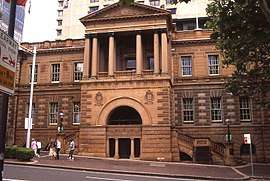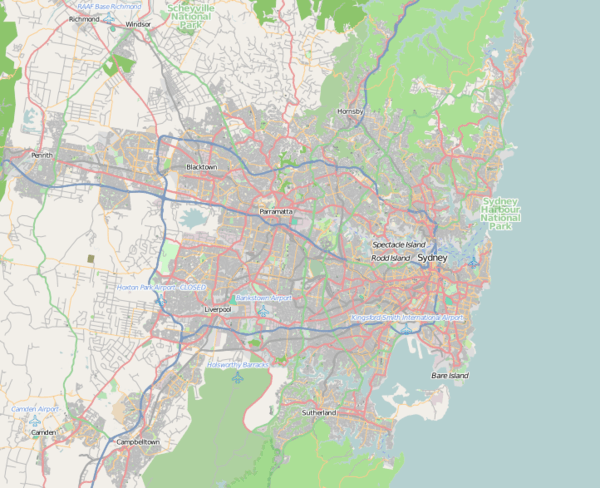Treasury Building, Sydney
| Treasury Building, Sydney | |
|---|---|
 | |
 Treasury building (former) Location in Greater Sydney | |
| Former names |
|
| Alternative names | InterContinental Hotel, Sydney |
| Etymology | |
| General information | |
| Status | Complete |
| Type |
|
| Architectural style | |
| Location | 117-119 Macquarie Street, Sydney, New South Wales |
| Country | Australia |
| Coordinates | 33°51′47″S 151°12′45″E / 33.8629516672°S 151.2124395890°ECoordinates: 33°51′47″S 151°12′45″E / 33.8629516672°S 151.2124395890°E |
| Construction started | 1849 |
| Renovated | 1982 – 1985 |
| Technical details | |
| Material | Sandstone; timber joinery; iron & stone palisade fence. |
| Design and construction | |
| Architect |
|
| Architecture firm | Colonial Architect of New South Wales |
| Official name | Intercontinental Hotel former Treasury Building |
| Criteria | a., c., d., e., f., g. |
| Designated | 2 April 1999 |
| Reference no. | 00355 |
| References | |
| [1][2][3] | |
The Treasury Building, or the Colonial Treasury Building, The Old Treasury Building, or the Treasury Building & Premier's Office, is an heritage-listed former government administration building located at the junction of Macquarie and Bridge streets in the central business district of Sydney in New South Wales, Australia.
Commenced in 1849 and completed in stages in 1851, 1853, 1900 and 1919 in the Victorian Neo-Classical and Italian Palazzo styles by NSW Colonial and Government architects Mortimer Lewis, Edmund Blacket, Walter Liberty Vernon, and George McRae, the building has been used variously by the NSW Treasury, the Audit Office, the Premier's Department, the Police Department, and the Ministry of Transport. In 1981 the building was sold to the InterContinental Hotel group, with a major hotel complex built on part of the site and much of the heritage building restored.[1]
Heritage listing
On 2 April 1999 the building was listed on the New South Wales State Heritage Register with the following statement of significance:[1]
The former Treasury Buildings group (within the Intercontinental Hotel complex) is an outstanding example of the state's 19th- early 20th century public buildings and forms part of what is arguably the finest group of these sandstone buildings in NSW. The architectural forms and detailing of the group, with its strong links to Victorian "Neo-Classical" traditions, make it an extremely fine exemplar of this style and reflect important contemporary links with English architectural practice. The facade of Lewis's original building in particular is a premier example in NSW of 19th century "Italian Palazzo" style based closely on a London model. The bold but sympathetically related Vernon additions fronting Macquarie Street are impressively proportioned and detailed and represent an excellent and perhaps unique example of late Victorian eclectic architecture in NSW. The site's contribution to the significant streetscapes of Macquarie and Bridge Streets is both large and indisputable, with the siting, form, materials and detailing enhancing the adjacent precincts of early buildings. Historically the building group is significant because of its long association with the NSW Treasury and the state treasurer's and premier's offices.
— Statement of significance, New South Wales State Heritage Register.
See also
References
- 1 2 3 "Intercontinental Hotel former Treasury Building". New South Wales State Heritage Register. Office of Environment and Heritage. Retrieved 7 November 2017.
- ↑ "Treasury Building & Premiers Office (Place ID 1829)". Australian Heritage Database. Department of the Environment. 21 March 1978. Retrieved 7 November 2017.
- ↑ "Former Treasury Building Including Interiors". New South Wales State Heritage Register. Office of Environment and Heritage. Retrieved 7 November 2017.
Attribution
| Wikimedia Commons has media related to Former NSW Treasury building. |
![]()